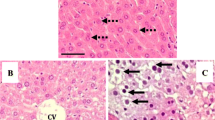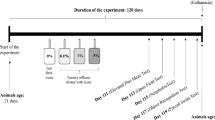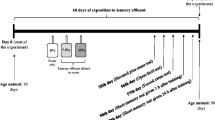Abstract
Oxidative stress has been considered as a central mechanism of toxicity induced by xenobiotics. Previously, it was demonstrated that mice exposed to tannery effluent showed an anxiety-like behavior, without any comparable behavioral effects in rats. The aim of the present study was to investigate the impact of tannery wastewater on oxidative status in in vitro and in vivo assays with two mammal species, mice and rats. Specifically, homogenates of two brain areas and the liver were incubated with tannery wastewater; reactive species and lipid peroxidation levels and antioxidant enzyme activities were detected. In addition, the effects of in vivo exposure of mice to tannery effluents on and lipid peroxidation levels and the total reactive antioxidant capacity in brain areas and liver. Brain areas, the hippocampus and frontal cortex, and the liver of mice exposed to tannery wastewater showed oxidative stress. Our data suggest that divergent species-dependent hepatic enzymes adaptations, such as glutathione peroxidase and glutathione S-transferase activities, induced by tannery effluent could explain previous behavioral findings.
Similar content being viewed by others
References
Adams JD, Wang B, Klaidman LK et al (1993) New aspects of brain oxidative stress induced by tert-butylhydroperoxide. Free Radic Biol Med 15:195–202. doi:10.1016/0891-5849(93)90059-4
Aquim PM (2009) Management in tanneries: integrated and efficient use of water (in Portuguese).
Åström A, Månér S, Depierre JW (1987) Induction of liver microsomal epoxide hydrolase, UDP-glucuronyl transferase and cytosolic glutathione transferase in different rodent species by 2-acetylaminofluorene or 3-methylcholanthrene. Xenobiotica 17:155–163
Avila-Costa MR, Colín-Barenque L, Fortoul TI et al (2009) Motor impairments in an oxidative stress model and its correlation with cytological changes on rat striatum and prefrontal cortex. Int J Neurosci 108:193–200
Bannerman D, Rawlins JN, McHugh S et al (2004) Regional dissociations within the hippocampus—memory and anxiety. Neurosci Biobehav Rev 28:273–283. doi:10.1016/j.neubiorev.2004.03.004
Bergamini CM, Gambetti S, Dondi A, Cervellati C (2004) Oxygen, reactive oxygen species and tissue damage. Curr Pharm Des 10:1611–1626. doi:10.2174/1381612043384664
Bertoldi K, Spindler C, dos Moysés FS et al (2012) Effect of landfill leachate on oxidative stress of brain structures and liver from rodents: modulation by photoelectrooxidation process. Ecotoxicol Environ Saf 84:319–324. doi:10.1016/j.ecoenv.2012.08.001
Bhattacharya P, Ghosh S, Mukhopadhyay A (2013) Combination technology of ceramic microfiltration and biosorbent for treatment and reuse of tannery efluent from different streams: response of defence system in Euphorbia sp. Int J Recycl Org Waste Agric 2:19
Bhattacharya P, Swarnakar S, Mukhopadhyay A, Ghosh S (2016) Exposure of composite tannery effluent on snail, Pila globosa: a comparative assessment of toxic impacts of the untreated and membrane treated effluents. Ecotoxicol Environ Saf 126:45–55. doi:10.1016/j.ecoenv.2015.12.021
Board PG, Menon D (2013) Glutathione transferases, regulators of cellular metabolism and physiology. Biochim Biophys Acta - Gen Subj 1830:3267–3288. doi:10.1016/j.bbagen.2012.11.019
Bouayed J, Rammal H, Younos C, Soulimani R (2007) Positive correlation between peripheral blood granulocyte oxidative status and level of anxiety in mice. Eur J Pharmacol 564:146–149. doi:10.1016/j.ejphar.2007.02.055
Bradford MM (1976) A rapid and sensitive method for the quantitation of microgram quantities of protein utilizing the principle of protein-dye binding. Anal Biochem 72:248–254. doi:10.1016/0003-2697(76)90527-3
Brocardo PS, Pandolfo P, Takahashi RN et al (2005) Antioxidant defenses and lipid peroxidation in the cerebral cortex and hippocampus following acute exposure to malathion and/or zinc chloride. Toxicology 207:283–291. doi:10.1016/j.tox.2004.09.012
Buege JA, Aust SD (1978) Microsomal lipid peroxidation. Methods Enzymol 52:302–310
Cassano A, Drioli E, Molinari R (1997) Recovery and reuse of chemicals in unhairing, degreasing and chromium tanning processes by membranes. Desalination 113:251–261. doi:10.1016/S0011-9164(97)00137-9
Chan LM, Lowes S, Hirst BH (2004) The ABCs of drug transport in intestine and liver: efflux proteins limiting drug absorption and bioavailability. Eur J Pharm Sci 21:25–51. doi:10.1016/j.ejps.2003.07.003
Chen J, Wang Y, Zhang H, Zhao X (2010) Overview on the studies of nitrate pollution in groundwater. Prog Geogr 25:34–44. doi:10.11820/DLKXJZ.2006.01.004
Dasuri K, Zhang L, Keller JN (2013) Oxidative stress, neurodegeneration, and the balance of protein degradation and protein synthesis. Free Radic Biol Med 62:170–185. doi:10.1016/j.freeradbiomed.2012.09.016
Davidson RJ (2002) Anxiety and affective style: role of prefrontal cortex and amygdala. Biol Psychiatry 51:68–80. doi:10.1016/S0006-3223(01)01328-2
Dean RT, Fu S, Stocker R, Davies MJ (1997) Biochemistry and pathology of radical-mediated protein oxidation. Biochem J 324:1–18. doi:10.1042/bj3240001
El-Demerdash FM (2011) Lipid peroxidation, oxidative stress and acetylcholinesterase in rat brain exposed to organophosphate and pyrethroid insecticides. Food Chem Toxicol 49:1346–1352. doi:10.1016/j.fct.2011.03.018
Evelson P, Travacio M, Repetto M, Escobar J, Llesuy S, Lissi EA (2001) Evaluation of total reactive antioxidant potential (TRAP) of tissue homogenates and their cytosols. Arch Biochem Biophys 388:261–266. doi:10.1006/abbi.2001.2292
Franco R, Sánchez-Olea R, Reyes-Reyes EM, Panayioisti MI (2009) Environmental toxicity, oxidative stress and apoptosis: Ménage à Trois. Mutat Res Toxicol Environ Mutagen 674:3–22. doi:10.1016/j.mrgentox.2008.11.012
Giannetti B, Bonilla S, Almeida CMV (2004) Developing eco-technologies: a possibility to minimize environmental impact in Southern Brazil. J Clean Prod 12:361–368. doi:10.1016/S0959-6526(03)00033-7
Guimarães ATB et al (2016) Anxiety and memory deficits induced by tannery effluent in C57BL/6J female mice. Environ Sci Pollut Res 23:25323–25334. doi:10.1007/s11356-016-7746-2
Habig WH, Pabst MJ, Jakoby WB (1974) Glutathione S-transferases. The first enzymatic step in mercapturic acid formation. J Biol Chem 249:7130–7139
Halliwell B, Chirico S (1993) Lipid peroxidation: its mechanism, measurement, and significance. Am J Clin Nutr 57:715S–724S
Han J, Won E-J, Hwang D-S et al (2013) Effect of copper exposure on GST activity and on the expression of four GSTs under oxidative stress condition in the monogonont rotifer, Brachionus koreanus. Comp Biochem Physiol Part C Toxicol Pharmacol 158:91–100. doi:10.1016/j.cbpc.2013.05.006
Hayes JD, McLellan LI (2009) Glutathione and glutathione-dependent enzymes represent a co-ordinately regulated defence against oxidative stress. Free Radic Res 31:273–300
Hovatta I, Tennant RS, Helton R et al (2005) Glyoxalase 1 and glutathione reductase 1 regulate anxiety in mice. Nature 438:662–666. doi:10.1038/nature04250
Igarashi T, Satoh T, Ueno K, Kitagawa H (1983) Species difference in glutathione level and glutathione related enzyme activities in rats, mice, guinea pigs and hamsters. Aust J Pharm 6:941–949. doi:10.1248/bpb1978.6.941
Jaeger N, Moraes JP, Klauck CR, Gehlenb G, Rodrigues MAS, Ziulkoski AL (2015) Cytotoxicity assays to evaluate tannery effluents treated by photoelectrooxidation. Braz J Biol 75:53–61 http://dx.doi.org/10.1590/1519-6984.01713suppl
Jamakala O, Rani UA (2015) Amelioration effect of zinc and iron supplementation on selected oxidative stress enzymes in liver and kidney of cadmium-treated male albino rat. Toxicol Int 22:1–9. doi:10.4103/0971-6580.172289
Landi S (2000) Mammalian class theta GST and differential susceptibility to carcinogens: a review. Mutat Res 463:247–283. doi:10.1016/S1383-5742(00)00050-8
LeBel CP, Ali SF, McKee M, Bondy SC (1990) Organometal-induced increases in oxygen reactive species: the potential of 2′,7′-dichlorofluorescin diacetate as an index of neurotoxic damage. Toxicol Appl Pharmacol 104:17–24. doi:10.1016/0041-008X(90)90278-3
Lissi E, Pascual C, del Castillo MD (1992) Luminol luminescence induced by 2,20-azo-bis(2-amidinopropane) thermolysis. Free Radic Res Commun 17:299–311
Lissi E, Salim-Hanna M, Pascual C, del Castillo MD (1995) Evaluation of total antioxidant potential (TRAP) and total antioxidant reactivity from luminol-enhanced chemiluminescence measurements. Free Radic Biol Med 18:153–158
Lowry OH, Rosenbrough NJ, Farr AL, Randall RJ (1951) Protein measurementwith the Folin phenol reagent. J Biol Chem 193:265–275
Ma J, Ding Z, Wei G et al (2009) Sources of water pollution and evolution of water quality in the Wuwei basin of Shiyang River, Northwest China. J Environ Manag 90:1168–1177. doi:10.1016/j.jenvman.2008.05.007
Maradonna F, Polzonetti V, Bandiera SM, Migliarini B, Carnevali O (2004) Modulation of the hepatic CYP1A1 system in the marine fish Gobius niger, exposed to xenobiotic compounds. Environ Sci Technol 38(23):6277–6282. doi:10.1021/es049786h
Margis R, Dunand C, Teixeira FK, Margis-Pinheiro M (2008) Glutathione peroxidase family—an evolutionary overview. FEBS J 275:3959–3970. doi:10.1111/j.1742-4658.2008.06542.x
Moysés FS, Bertoldi K, Spindler C et al (2014) Exposition to tannery wastewater did not alter behavioral and biochemical parameters in Wistar rats. Physiol Behav 129:160–166. doi:10.1016/j.physbeh.2014.02.022
Muthuswamy AD, Vedagiri K, Ganesan M, Chinnakannu P (2006) Oxidative stress-mediated macromolecular damage and dwindle in antioxidant status in aged rat brain regions: role of l-carnitine and dl-α-lipoic acid. Clin Chim Acta 368:84–92. doi:10.1016/j.cca.2005.12.010
Oral R, Meriç S, De Nicola E, Petruzzelli D, Della Rocca C et al (2007) Multi-species toxicity evaluation of a chromium-based leather tannery wastewater. Desalination 211(1):48–57. doi:10.1016/j.desal.2006.02.084
Prabakaran M, Binuramesh C, Steinhagen D, Dinakaran Michael R (2007) Immune response in the tilapia, Oreochromis mossambicus on exposure to tannery effluent. Ecotoxicol Environ Saf 68:372–378. doi:10.1016/j.ecoenv.2006.11.016
Ramos-Gomez M, Kwak M-K, Dolan PM et al (2001) Sensitivity to carcinogenesis is increased and chemoprotective efficacy of enzyme inducers is lost in nrf2 transcription factor-deficient mice. Proc Natl Acad Sci 98:3410–3415. doi:10.1073/pnas.051618798
Sheehan D, Meade G, Foley VM, Dowd CA (2001) Structure, function and evolution of glutathione transferases: implications for classification of non-mammalian members of an ancient enzyme superfamily. Biochem J 360:1–16. doi:10.1042/bj3600001
Siddique HR, Gupta SC, Dhawan A et al (2005) Genotoxicity of industrial solid waste leachates in Drosophila melanogaster. Environ Mol Mutagen 46:189–197. doi:10.1002/em.20149
Siddique HR, Gupta SC, Mitra K et al (2008) Adverse effect of tannery waste leachates in transgenic Drosophila melanogaster: role of ROS in modulation of Hsp70, oxidative stress and apoptosis. J Appl Toxicol 28:734–748. doi:10.1002/jat.1332
Siqueira IR, Vanzella C, Bianchetti P et al (2011) Anxiety-like behaviour in mice exposed to tannery wastewater: the effect of photoelectrooxidation treatment. Neurotoxicol Teratol 33:481–484. doi:10.1016/j.ntt.2011.05.008
Tagliari KC, Cecchini R, Rocha JAV, Vargas VMF (2004) Mutagenicity of sediment and biomarkers of oxidative stress in fish from aquatic environments under the influence of tanneries. Mutat Res Toxicol Environ Mutagen 561:101–117. doi:10.1016/j.mrgentox.2004.04.001
Tang JYM, Busetti F, Charrois JWA, Escher BI (2014) Which chemicals drive biological effects in wastewater and recycled water? Water Res 60:289–299. doi:10.1016/j.watres.2014.04.043
Tare V, Gupta S, Bose P (2012) Case studies on biological treatment of tannery effluents in India. J Air Waste Manag Assoc 53:976–982. doi:10.1080/10473289.2003.10466250
Tickner JA, Schettler T, Guidotti T et al (2001) Health risks posed by use of di-2-ethylhexyl phthalate (DEHP) in PVC medical devices: a critical review. Am J Ind Med 39:100–111. doi:10.1002/1097-0274(200101)39:1<100::AID-AJIM10>3.0.CO;2-Q
Tigini V, Giansanti P, Mangiavillano A et al (2011) Evaluation of toxicity, genotoxicity and environmental risk of simulated textile and tannery wastewaters with a battery of biotests. Ecotoxicol Environ Saf 74:866–873. doi:10.1016/j.ecoenv.2010.12.001
Wendel A, Feuerstein S (1981) Drug-induced lipid peroxidation in mice—I. Modulation by monooxegenase activity, glutathione and selenium status. Biochem Pharmacol 30:2513–2520. doi:10.1016/0006-2952(81)90576-1
Yagi K (1998) Simple assay for the level of total lipid peroxides in serum or plasma. Methods Mol Biol 108:101–106. doi:10.1385/0-89603-472-0:101
Acknowledgments
This work was supported by the Brazilian funding agencies: Fundação de Amparo à Pesquisa do Rio Grande do Sul—PROCOREDES III; FAPERGS/1981-2551/13-4; FUNADESP/UNIVATES; Coordenação de Aperfeiçoamento de Pessoal de Nível Superior—CAPES (Dr. F. S. Moysés); Conselho Nacional de Desenvolvimento Científico e Tecnológico—CNPq (Dr. I.R. Siqueira; Dr. M.A.S. Rodrigues; Dr. S. Stülp; Dr. F. S. Moysés; Dr. V.R. Elsner; Dr. K. Bertoldi).
Author information
Authors and Affiliations
Corresponding author
Ethics declarations
The NIH “Guide for the Care and Use of Laboratory Animals” (NIH publication No. 80-23, revised 1996) was followed in all experiments that were conducted at room temperature (22 ± 1 °C). All experiments were approved by the Local Institutional Research Committee).
Conflict of interest
The authors declare that they have no conflicts of interest.
Additional information
Responsible editor: Markus Hecker
Rights and permissions
About this article
Cite this article
dos Santos Moysés, F., Bertoldi, K., Elsner, V.R. et al. Effect of tannery effluent on oxidative status of brain structures and liver of rodents. Environ Sci Pollut Res 24, 15689–15699 (2017). https://doi.org/10.1007/s11356-017-9149-4
Received:
Accepted:
Published:
Issue Date:
DOI: https://doi.org/10.1007/s11356-017-9149-4




